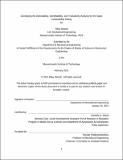| dc.contributor.advisor | Danielle R. Wood. | en_US |
| dc.contributor.author | Steindl, Riley M. | en_US |
| dc.contributor.other | Massachusetts Institute of Technology. Department of Mechanical Engineering. | en_US |
| dc.date.accessioned | 2021-05-25T18:23:36Z | |
| dc.date.available | 2021-05-25T18:23:36Z | |
| dc.date.copyright | 2021 | en_US |
| dc.date.issued | 2021 | en_US |
| dc.identifier.uri | https://hdl.handle.net/1721.1/130865 | |
| dc.description | Thesis: S.M., Massachusetts Institute of Technology, Department of Mechanical Engineering, February, 2021 | en_US |
| dc.description | Cataloged from the official PDF version of thesis. | en_US |
| dc.description | Includes bibliographical references (pages 117-120). | en_US |
| dc.description.abstract | Three of the core activities in maintaining Space Situational Awareness (SSA) efforts are the Detection, Identification, and Tracking of Anthropogenic Space Objects (ASOs). For much of the space age, the onus for improving global SSA has fallen primarily on the ground-based satellite surveillance and tracking community, leading to more technically advanced and powerful sensing systems. With the focus on improving sensor design for SSA purposes, designers of surveillance and tracking systems have been able to push the envelope of observing increasingly smaller ASOs. Meanwhile, ventures in the use of nanosatellite and picosatellite architectures for commercial business models have become increasingly popular due to their lower material and launch costs. The proliferation of these small ASOs has made it easier than ever to add to the orbital population while also stretching thin the increasingly taxed ground-based sensing systems on which the world depends for SSA. | en_US |
| dc.description.abstract | With the number of ASOs in orbit increasing rapidly, effort is required from both the sensing and satellite communities to ensure that humans can maintain adequate SSA for the foreseeable future. To aid in these efforts, the Detectability, Identifiability, and Trackability (DIT) analyses have been developed through this thesis work to quantitatively assess how difficult it is to detect, identify, and track ASOs from the Earth as a function of orbital and spacecraft characteristics. The DIT analysis first assumes a fictional network of medium quality ground-based sensors with optical and radar observation capabilities that are distributed in geographic locations around the world providing excellent coverage in high, middle and low latitudes. | en_US |
| dc.description.abstract | The Detectability analysis utilizes geometric approximations of the shape of an ASO, along with its orbital parameters, to produce estimates of its visual magnitude and probability of detection by radar, in order to determine whether or not an ASO is likely to be detectable by the assumed ground sensor network. The Trackability analysis characterizes how the ASO's orbit interacts with the generically defined ground sensor network over time. Utilizing access statistics for both optical and radar sensing modes, the Trackability analysis calculates the percentage of the orbit that is tracked by the network, average time between ground sensor access and the duration of the access. These metrics inform how much information is available to improve state estimation for the ASO. Finally, for the Identifiability analysis, the vision is to describe how difficult it would be for an uninformed observer to determine if a given ASO can be matched to a known record in a catalog of space objects. | en_US |
| dc.description.abstract | The author has been exploring an approach proposed by Professor Moriba Jah of the University of Texas at Austin based on clustering analysis of ASO orbital angular momentum data. Currently this analysis is limited to the population size data for each cluster, but work is underway to incorporate ASO characteristic data. The goal of including characteristic data is to consider groups of satellites that share common characteristics as sharing a so-called "orbital zip code". The analysis asks how many objects within a given orbital zip code are indistinguishable from the ASO based on data that can be observed by a ground observer with no prior information about the ASO. This paper delves into the specifics of the analysis and discusses the current plans for its implementation. While still a work-in-progress, work is underway to address the limitations of the analysis and improve its functionality. | en_US |
| dc.description.abstract | The author has also been working closely with the developers of the Space Sustainability Rating (SSR), an initiative to create an incentive system to reward operators of satellites that take actions to reduce space debris and collision risk. The methods from the DIT analysis will be used as one of the scoring inputs for the Space Sustainability Rating. | en_US |
| dc.description.statementofresponsibility | by Riley Steindl. | en_US |
| dc.format.extent | 129 pages | en_US |
| dc.language.iso | eng | en_US |
| dc.publisher | Massachusetts Institute of Technology | en_US |
| dc.rights | MIT theses may be protected by copyright. Please reuse MIT thesis content according to the MIT Libraries Permissions Policy, which is available through the URL provided. | en_US |
| dc.rights.uri | http://dspace.mit.edu/handle/1721.1/7582 | en_US |
| dc.subject | Mechanical Engineering. | en_US |
| dc.title | Developing the detectability, identifiability, and trackability analysis for the space sustainability rating | en_US |
| dc.type | Thesis | en_US |
| dc.description.degree | S.M. | en_US |
| dc.contributor.department | Massachusetts Institute of Technology. Department of Mechanical Engineering | en_US |
| dc.identifier.oclc | 1252632107 | en_US |
| dc.description.collection | S.M. Massachusetts Institute of Technology, Department of Mechanical Engineering | en_US |
| dspace.imported | 2021-05-25T18:23:36Z | en_US |
| mit.thesis.degree | Master | en_US |
| mit.thesis.department | MechE | en_US |
